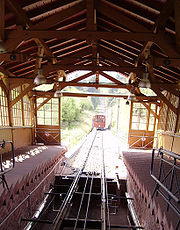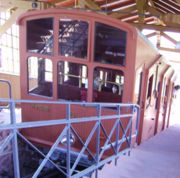
Heidelberger Bergbahn
Encyclopedia


Funicular
A funicular, also known as an inclined plane or cliff railway, is a cable railway in which a cable attached to a pair of tram-like vehicles on rails moves them up and down a steep slope; the ascending and descending vehicles counterbalance each other.-Operation:The basic principle of funicular...
in the city of Heidelberg
Heidelberg
-Early history:Between 600,000 and 200,000 years ago, "Heidelberg Man" died at nearby Mauer. His jaw bone was discovered in 1907; with scientific dating, his remains were determined to be the earliest evidence of human life in Europe. In the 5th century BC, a Celtic fortress of refuge and place of...
, Germany
Germany
Germany , officially the Federal Republic of Germany , is a federal parliamentary republic in Europe. The country consists of 16 states while the capital and largest city is Berlin. Germany covers an area of 357,021 km2 and has a largely temperate seasonal climate...
. The first section runs from a lower station at Kornmakt in Heidelberg's Altstadt, via an intermediate station at Heidelberg Castle
Heidelberg Castle
The Heidelberg Castle is a famous ruin in Germany and landmark of Heidelberg. The castle ruins are among the most important Renaissance structures north of the Alps....
, to an upper station at Molkenkur. Here passengers may change to the second section, which runs to the Königstuhl
Königstuhl (Odenwald)
The Königstuhl , translated "Kings seat", is a 567 metre high hill in the Odenwald Mountains and in the city of Heidelberg, in the German state of Baden-Württemberg. The Königstuhl summit allows visitors a spectacular view of the city of Heidelberg and the River Neckar as well as the Rhine Valley...
, a nearby mountain with good views over the city and the River Neckar
Neckar
The Neckar is a long river, mainly flowing through the southwestern state of Baden-Württemberg, but also a short section through Hesse, in Germany. The Neckar is a major right tributary of the River Rhine...
.
The upper and lower sections of the funicular have different histories and are sometimes referred to separately by the names Königstuhlbahn and Molkenkurbahn respectively. These two sections present quite different appearances, with the upper section using wooden bodied cars of historic appearance, whilst the lower section uses modern style cars. Similarly the upper stations at Molkenkur and Königstuhl are to the original design, whilst those further down the hill at Kornmakt and Heidelberg Castle present a more modern image.
The Heidelberger Bergbahn is operated by the Heidelberger Straßen- und Bergbahn AG (HSB), the operator of Heidelberg's tram
Tram
A tram is a passenger rail vehicle which runs on tracks along public urban streets and also sometimes on separate rights of way. It may also run between cities and/or towns , and/or partially grade separated even in the cities...
and bus
Bus
A bus is a road vehicle designed to carry passengers. Buses can have a capacity as high as 300 passengers. The most common type of bus is the single-decker bus, with larger loads carried by double-decker buses and articulated buses, and smaller loads carried by midibuses and minibuses; coaches are...
system, although the funicular predominantly serves tourist traffic. The lower section runs every 10 minutes throughout the day, whilst the connecting upper section runs every 20 minutes throughout the day. The services start and end at times that vary from summer to winter.
Lower section

Nerobergbahn
The Nerobergbahn is a funicular railway in the city of Wiesbaden, Germany. The line links the city with the Neroberg hill to its north, where visitors may view a panorama of the city....
in Wiesbaden
Wiesbaden
Wiesbaden is a city in southwest Germany and the capital of the federal state of Hesse. It has about 275,400 inhabitants, plus approximately 10,000 United States citizens...
. The line was rebuilt to use a conventional electric drive in 1907. Between 1961 and 1962 the section was rebuilt and new cars provided in order to handle the volume of traffic to Heidelberg Castle; at this time new stations were built at Kornmakt and Heidelberg Castle. The section was closed between October 2003 and March 2005; during the closure period the existing cars were scrapped and replaced by new and larger cars to a modern design, and Kornmarkt and Heidelberg Castle stations were again rebuilt.
The section has the following technical parameters:
- Length: 471 metres
- Height: 171 metres
- Maximum steepness: 43 %
- Configuration: Single track with passing loop
- Journey time: 5 minutes
- Cars: 2
- Capacity: 130 passengers per car
- Track gauge: 1 metre
- Traction: Electricity
Upper section

The section has the following technical parameters:
- Length: 1020 metres
- Height: 260 metres
- Maximum steepness: 41 %
- Configuration: Single track with passing loop
- Journey time: 9 minutes
- Cars: 2
- Capacity: 50 passengers per car
- Track gauge: 1 metre
- Traction: Electricity
External links
- Official web site of the Bergbahnen (English version)
- Official web site of the Bergbahnen (German version)

